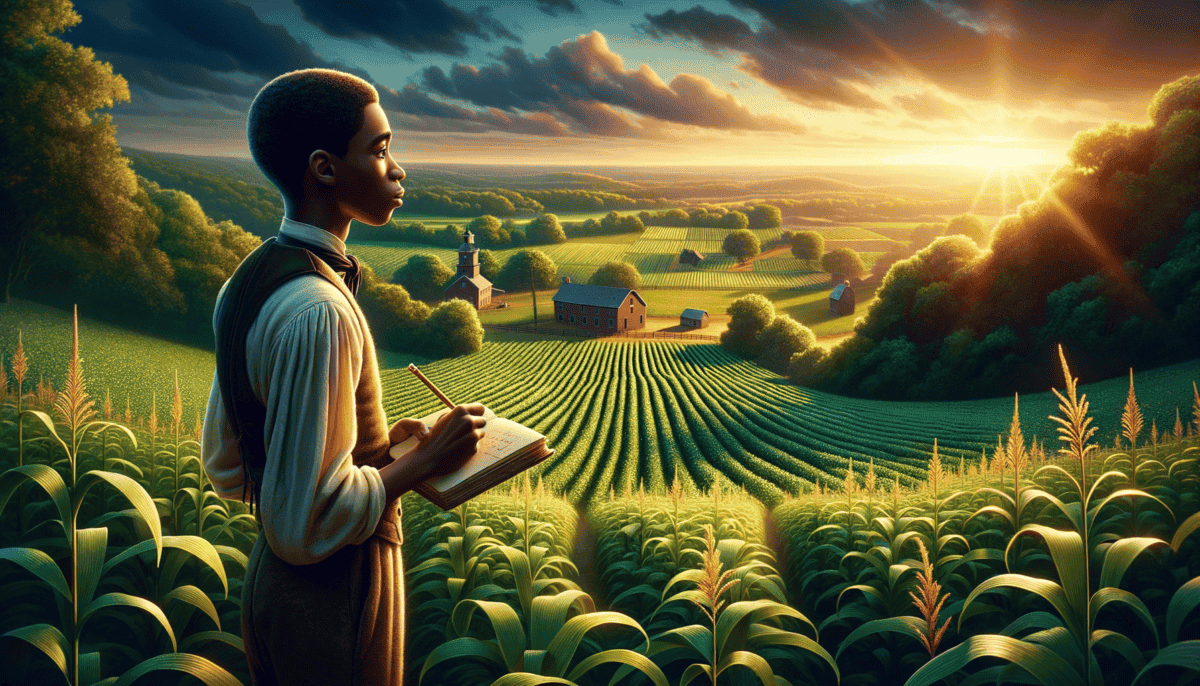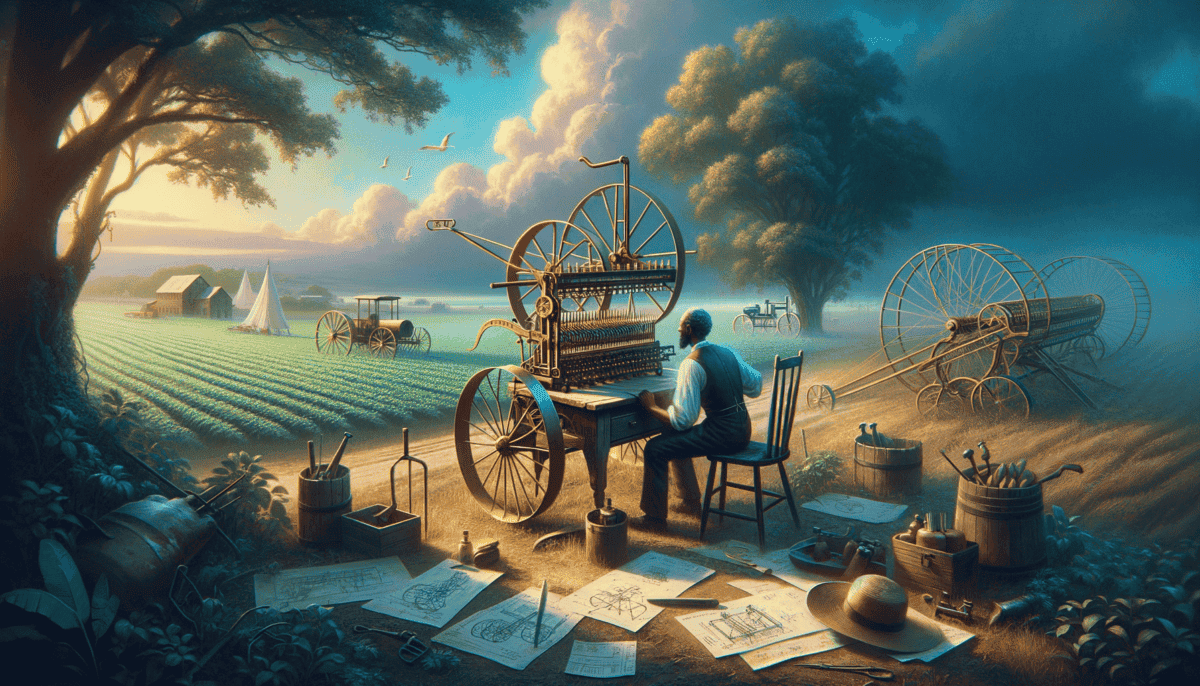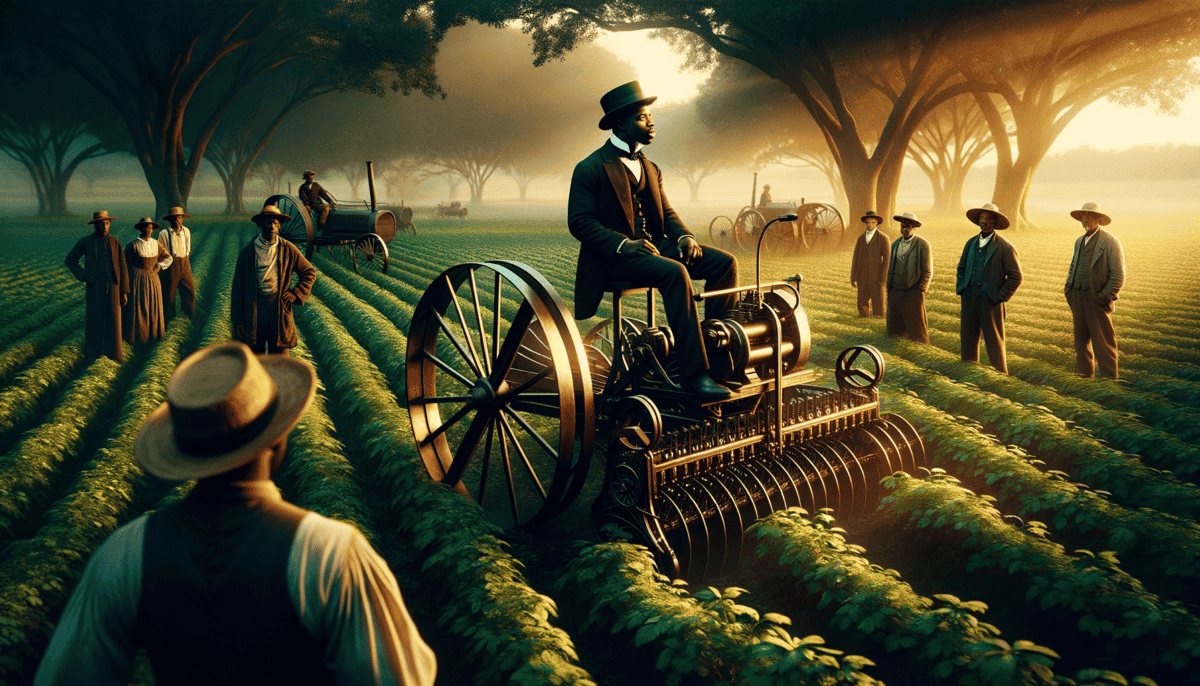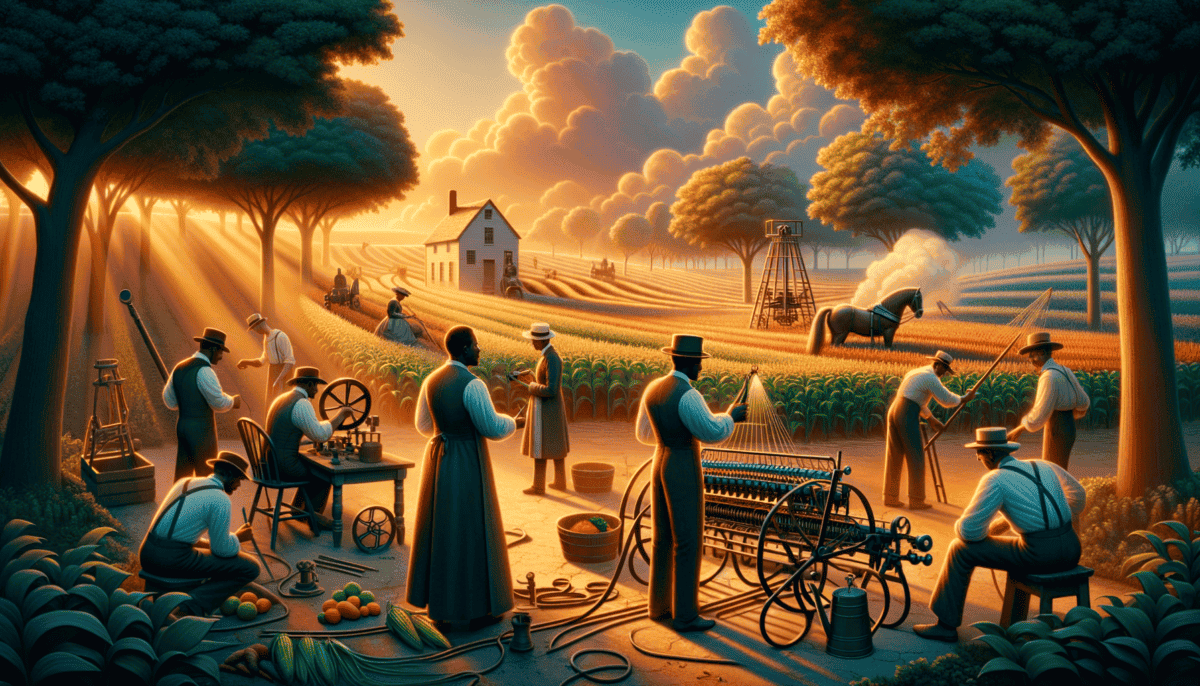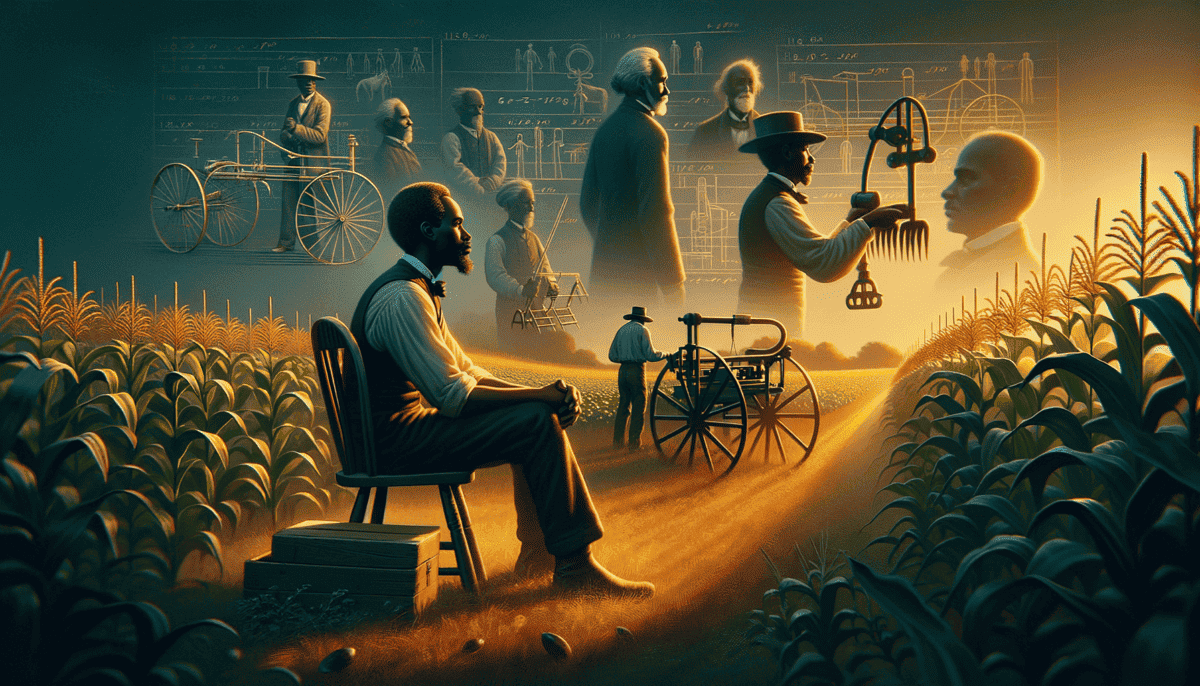Seeds of Curiosity
The warm Maryland sun peeked through the clouds as young Henry Blair walked through his family's farm. The year was 1820, and the ten-year-old boy already had big dreams.
"Papa, why do we have to plant each seed by hand?" Henry asked, watching his father bend down again and again in the field.
His father wiped sweat from his brow. "That's just how it's done, son. Always has been."
But Henry wasn't satisfied with that answer. He watched as the other farmers worked too, their backs aching as they dropped seeds one by one into the soil. There had to be a better way!
Farm Life Adventures
Every morning, Henry would wake up early to help with the farm chores:
• Feed the chickens
• Water the crops
• Help plant seeds
• Collect eggs
• Clean the barn �barn
One day, while helping in the fields, Henry noticed something interesting. "The seeds need to be planted at just the right depth," he thought. "And they need to be spaced just right too."
He grabbed his father's old notebook and started drawing. His first sketch looked like a wheelbarrow with special parts to plant seeds. It wasn't perfect, but it was a start!
Young Problem Solver
"What are you drawing there, Henry?" his mother asked one evening.
Henry's eyes lit up. "I'm making a machine that can plant seeds faster than doing it by hand!"
His mother smiled. "You've always been clever with solving problems."
“Sometimes the best ideas come from watching and thinking,” she told him. “Keep watching, keep thinking, and keep drawing.”
Henry took those words to heart. Every day, he looked for ways to make farming easier. He watched how the horses pulled plows through the fields. He studied how seeds fell into the soil. Each observation gave him new ideas.
Drawing Dreams
At night, by candlelight, Henry would work on his drawings. He imagined a machine that could:
✓ Cut into the soil
✓ Drop seeds at the right depth
✓ Cover the seeds with dirt
✓ Do it all faster than by hand
Other kids might have given up, but not Henry. Even when his first ideas didn't work, he kept trying. He knew that somewhere in his drawings was the answer to helping farmers work better.
"One day," he told himself, "I'm going to build something that helps everyone on their farms."
Little did young Henry know that his childhood dreams would grow into something much bigger. His curious mind and determination would one day change farming forever.
As the sun set over the Maryland fields, Henry added one more drawing to his notebook. Tomorrow would bring new ideas, new challenges, and new chances to make his dreams come true.
The Corn Planter Dream
Henry Blair stood in his workshop, now a grown man with calloused hands and determined eyes. The year was 1834, and his childhood dreams were about to become real. ️
“Look at this, Thomas,” Henry said to his friend, pointing to his latest drawing. “I think I’ve finally figured it out!”
A Big Problem to Solve
Farming in the 1830s was very hard work. Farmers had to:
- Dig holes by hand
- Drop seeds one by one
- Cover each seed with dirt
- Do this hundreds of times!
“There must be a better way,” Henry would say as he watched farmers bend over their fields all day long.
Building the Dream Machine
Henry started building his corn planter using simple things:
• Wood from old barns
• Metal pieces he could find
• Wheels from broken carts
“Sometimes the best inventions come from simple things,” Henry told himself as he worked.
Testing and Trying Again
Not everyone believed in Henry’s idea. Some people laughed.
“A machine that plants corn? Impossible!” they said.
But Henry didn’t listen to the doubters. He kept working on his invention. When something broke, he fixed it. When something didn’t work right, he tried again.
How It Worked
Henry’s corn planter was clever! It looked like a big wheelbarrow with special parts:
✓ Two wooden boxes held the seeds
✓ Sharp blades cut into the soil
✓ Seeds dropped at just the right spots
✓ Small plows covered the seeds with dirt
Breaking Through Barriers
Being a Black inventor in the 1830s wasn’t easy. Many people didn’t want to help Henry:
“Sorry, we can’t lend you money,” the banks would say.
“We don’t work with your kind,” some stores told him.
But Henry kept going. He used his own money. He found friendly people who would help. Nothing could stop his dream!
The First Success
Finally, the big day came to test the corn planter. Henry hitched it to a horse and walked into the field.
“Watch this!” he called to the crowd of curious farmers.
The machine worked perfectly! It cut into the soil, dropped seeds, and covered them up – all while Henry simply walked behind it.
One farmer shouted, “It’s doing the work of three men!”
Another said, “I’ve never seen anything like it!”
Henry smiled. His childhood dream was becoming real. But he wasn’t done yet – he had more ideas growing in his clever mind…
Patent Path
Henry Blair walked up the steps of the Patent Office in Washington, D.C. His heart was beating fast. Under his arm, he carried his precious drawings of the corn planter.
“Good morning, sir,” the clerk said, looking surprised to see him. “How may I help you?”
“I’m here to apply for a patent,” Henry said proudly. “I’ve invented a new machine for planting corn.”
Drawing the Details
Henry spread his drawings on the desk. He had worked on them for weeks:
• Every part was carefully drawn
• All the measurements were exact
• He showed how each piece moved
“Your drawings are very detailed, Mr. Blair,” the clerk admitted, looking impressed.
Waiting and Hoping
Getting a patent wasn’t easy. Henry had to:
- Fill out lots of papers
- Pay special fees
- Answer many questions ❓
- Wait for months ⏰
Some people at the Patent Office weren’t sure about giving a patent to a Black inventor. But Henry’s invention was too good to ignore!
The Big News
One sunny morning in October 1834, a letter arrived. Henry’s hands shook as he opened it.
“We did it!” Henry shouted, hugging his wife. “We really did it!”
Spreading the Word
News of Henry’s patent spread quickly. Some people were shocked:
“A Black man got a patent?” they whispered.
“How is this possible?” others asked.
But many farmers were excited:
“Finally, someone made farming easier!” they said. “We don’t care who invented it – it works!”
Showing Others the Way
Henry’s success gave hope to other Black inventors. They thought:
✓ If Henry could do it
✓ Maybe they could too
✓ Dreams can come true
✓ Hard work pays off
More Ideas Growing
But Henry wasn’t done inventing. As he watched farmers working with cotton, new ideas started growing in his mind.
“The cotton fields need help too,” he thought. “And I think I know just what to do!”
Henry looked out at the fields, already planning his next invention. His corn planter was just the beginning of something big…
Cotton Planter Revolution
The sun was hot in the cotton fields as Henry Blair watched farmers struggle with their work. Their backs were bent as they planted seeds one by one.
A New Challenge
Henry pulled out his notebook and started drawing. This machine would be different from his corn planter. It needed to:
- Split open the ground
- Drop seeds carefully
- Cover them back up
- Work with horses
Building the Dream
“Pass me that hammer, John,” Henry called to his helper. They were building the first cotton planter in his workshop.
“This machine will change everything!” John said excitedly.
Day after day, they worked on the planter:
• Adding sharp blades to cut the soil
• Making wheels that rolled smoothly
• Creating seed boxes that worked just right
Testing Time
Farmers came from miles around to watch. Henry hitched his machine to a horse named Star.
“Watch this!” Henry called out. Star started walking, pulling the planter behind him.
Magic in the Fields
The crowd gasped as they saw:
✓ Blades cutting neat rows
✓ Seeds dropping perfectly
✓ Soil covering everything up
“It’s like magic!” someone shouted.
“No,” Henry smiled. “It’s science and hard work!”
Changing Farming Forever
The cotton planter made big changes:
“One person and a horse can now do the work of many!” Henry explained proudly.
Farmers loved it because:
• It saved time ⏰
• It saved money
• It made work easier
Success Grows
“Now we have two great machines,” Henry told his wife. “But I’m not done yet!”
He looked at his workshop, already thinking about new ways to help farmers. The cotton planter was amazing, but Henry Blair had more dreams to build…
Breaking New Ground
The year was 1836, and Henry Blair’s inventions were changing farms across Maryland. But life wasn’t always easy for a Black inventor.
Making a Difference
“Your planters saved us weeks of work,” a farmer named Tom told Henry. “We planted our whole field in just two days!”
“That’s why I created them,” Henry smiled. “To make farming better for everyone.”
Farmers everywhere were talking about Henry’s inventions:
- The corn planter made planting fast
- The cotton planter made work easier
- Both machines saved money
Facing Challenges
But not everyone was happy about Henry’s success. Some people didn’t think a Black man should be an inventor.
“Don’t listen to them,” Henry’s wife Sarah said. “Your work helps people. That’s what matters.”
Teaching Others
Henry started teaching young people about inventing:
• How to draw designs ✏️
• How to build machines
• How to solve problems
“You can be an inventor too,” he told them. “Just watch, think, and try new things.”
Growing Fame
“Mr. Blair’s machines are remarkable!” wrote a newspaper. “They show what one creative mind can do.”
More people wanted to learn about Henry’s story:
• Farmers came to see his machines
• Students wanted to learn from him
• Other inventors asked for advice
New Dreams Growing
“Every problem has a solution,” he often said. “We just have to find it.”
In his workshop, Henry looked at his newest drawings. He wasn’t done inventing yet. There were still more ways to make farming better…
Inspiring Others
Young inventors started following Henry’s example:
“If Mr. Blair can do it, so can I!” said Mary, a young girl who loved making things.
Henry smiled when he heard this. His work was doing more than helping farmers – it was showing others they could follow their dreams too.
Each night, as Henry worked on new ideas, he thought about all the people his inventions helped. That made all the hard work worth it.
Seeds of Tomorrow
The sun was setting on Henry Blair’s workshop, casting long shadows over his life’s work. His inventions had changed farming forever.
A Special Visit
One spring morning, a group of children visited Henry’s workshop. Their eyes grew wide at the sight of his inventions.
“How did you know what to make?” asked a small boy named James.
“I watched, I listened, and I never gave up,” Henry answered with a warm smile. “That’s the secret to inventing.”
Looking Back
Henry showed the children his first drawings from years ago:
• Simple sketches of the corn planter ✏️
• Plans for the cotton planter
• Notes about making farming better
Sharing Wisdom
“Mr. Blair,” asked Sarah, a young girl, “what should we do to become inventors?”
Henry shared his most important lessons:
- Always watch for problems that need fixing
- Don’t be afraid to try new ideas
- Keep working even when things get hard
- Share your knowledge with others
Growing Hope
“Your inventions changed everything,” said Tom, an old farmer. “You made life better for all of us.”
The Future Grows
Years later, farmers still used Henry’s planters. But more importantly, his story inspired new inventors:
• Young people dreamed bigger dreams
• More Black inventors got patents
• Farming kept getting better
The Greatest Gift
“Remember,” Henry told the children as they left, “the best inventions help people. That’s what matters most.”
As the sun set on Henry Blair’s workshop one last time, his legacy was clear. He had planted more than corn and cotton – he had planted hope, courage, and dreams that would grow for generations to come.

